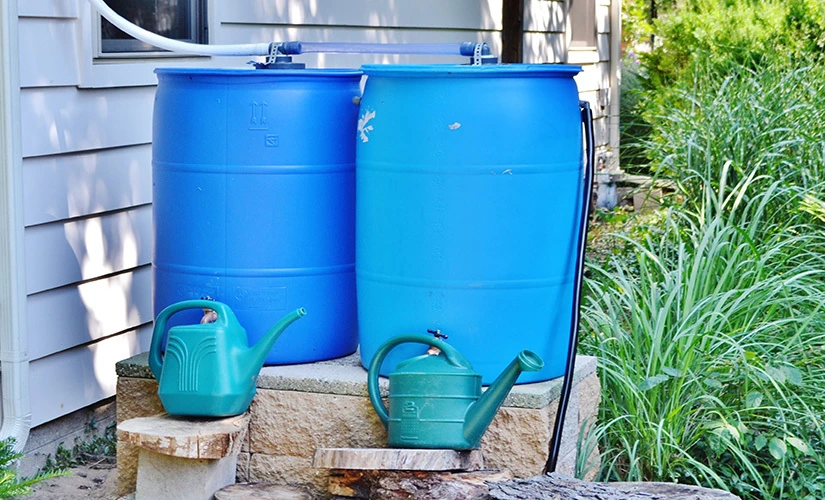How Do Rain Barrels Work for Water-Conscious Homeowners?
Rain barrels collect fresh rainwater that would otherwise become runoff. Beyond that, rain barrels are a great way to reduce municipal water dependence, water your plants in a more eco-conscious manner and save money on your water bill.
Learn all about how rain barrels work and how to make a rain barrel at home.

What Is a Rain Barrel System?
Rain barrels are small, outdoor tanks that collect excess rainwater from gutters and downspouts. This is water that would otherwise collect trash, pollution, and fertilizers, eventually ending up in groundwater and the ocean.
How do rain barrels work, exactly? They work with gravity to divert water from your gutters and collect it in the barrel. There’s at least one spigot on the barrel near the bottom. The spigot can be pressurized naturally with gravity for simple tasks like filling buckets. Or it can be connected to a pump system for irrigation.
Installing a rain barrel system helps you smartly re-purpose would-be water runoff.
Before you begin: If you live somewhere with regular heavy rains or poor drainage, you should always start with protecting your property from water damage and making sure your home is properly ventilated. Once you’re sure you won’t suffer from mold, flooding and soil erosion, you can concentrate on collecting excess rainwater.
Choose the Right Rain Barrel System
You can buy the barrel and build the rest of the system yourself, or you can purchase a full kit. The material and size of rain barrel you choose depends on the aesthetics of your home and your family’s needs.
Here are the main types of rain barrels:
- Plastic-polyethylene. These are the most inexpensive barrels. Made of sturdy, lightweight plastic, they are easy to install and can be very attractive. (Try a faux terra cotta version!) This type of rain barrel shouldn’t be in direct sunlight, as the material might break down from UV damage over time.
- Oak. Oak wood rain barrels are handsome options for homeowners interested in a rustic look. They can be more expensive and heavier than other materials, and they tend to look more rustic over time.
- Metal. Metal rain barrels may not be very attractive, but they are sturdy. These are a good choice for a permanent installation, or for households that want to collect a lot of water.
- Waterstone. Imitation stone-finish water barrels are smaller than other barrels, but they successfully camouflage your rain barrel system and protect it from insects or other pests.
How to Make a Rain Barrel System
After you’ve purchased a barrel, make a rain barrel system with these steps:
- First things first – you’ll need clean and efficient gutters. Window Genie® is a gutter cleaning dream team; see if there’s a location serving your area.
- Choose your spot. A corner of your home is ideal, at the end of the gutter water flow. Choose a place near any gardens or water features you’d like to feed water to.
- Build a raised platform. Cinderblocks or four-by-four lumber are inexpensive options. Check the platform with a level before placing your barrel on top.
- Measure your barrel height. This will tell you how high your downspout will need to be for water to easily flow into the barrel.
- Shorten your existing gutter downspout, or install a downspout diverter above your new barrel and its platform
- Do a test run. Pour some water into your gutter to make sure it flows properly into the barrel. Seal any leaks. Add wall supports to the drainpipe if necessary.
- Wait for the rain!
Or skip the installation process entirely, and check if there’s a local Mr. Handyman® team to do it for you.
Are Rain Barrels Legal?
Most states encourage rainwater collection and consider it an eco-friendly practice. The few states that do restrict rainwater collection have size limits for rainwater barrels. Check with your state and local governments before you look into how to make a rain barrel system.
How to Use Water from a Rain Barrel
Rainwater is not necessarily safe for drinking, or “potable,” unless you purify it with a complicated filtration process. These are ways to safely use water from your rain barrel system:
- Water your garden and lawn. If you love plants but hate your high water bills, use a rain barrel for watering your plants and lawn. This is especially helpful in areas that require water rationing. Plus, plants love the nutrients in rainwater!
- Fill birdbaths. Attract some feathery friends to your backyard with a clean, inviting birdbath.
- Wash your home or car. Rainwater doesn’t contain all the hard minerals that tap water does, so it can be great for cleaning.
- Build a natural outdoor shower. Water is terrific at storing solar energy as heat during the day. Attach a filter and downspout to the rain barrel system to make a natural outdoor shower. Consult these tips for proper outdoor shower drainage.
If you’re looking for even more ways to save water, consider getting that leaky faucet or inefficient toilet fixed. Find out if there’s a local Mr. Rooter® to help you stop wasting water.
Love Your Home Even More
You’re well on your way to a greener, more efficient home! Consider other ways to make your lifestyle more sustainable and convenient, such as composting with these tips from The Grounds Guys®.
To find experts for eco-friendly home improvements and any other project, search for services through Neighborly®.



 Back
Back

 1 (855) 217-8437
1 (855) 217-8437


